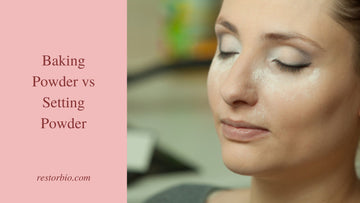
It might be challenging to choose which sort of powder is appropriate for your needs while selecting the proper one for your makeup.
Face powder comes in both baking and setting varieties, although they serve distinct functions.
What exactly is the difference between setting powder and baking powder? Find out by continuing to read!
What does it mean to "bake your makeup"?
In order to apply baking powder makeup, you must leave the powder on your face for a considerable amount of time, usually between 10 and 15 minutes.
The heat from your face dries off your makeup, giving you a matte effect that lasts for a long time.
Although it can be used on the entire face, baking is frequently used to set concealer under the eyes and accentuate cheekbones.
If you have mature skin, it's crucial to use caution when baking because it might exaggerate wrinkles and fine lines.
What does baking powder for cosmetics do?
A common setting powder used by makeup artists to fix foundation and concealer is cosmetic baking powder.
It is often applied using a moist sponge or Beautyblender, "baked" for a few minutes, and then removed with a brush.
Baking powder has a mattifying effect that can assist to decrease shine in addition to helping to set makeup in place.
The act of "baking" aids in lifting and softening the look of wrinkles and fine lines.
As a result, a lot of individuals think using makeup baking powder is necessary to get a flawless makeup look.
What is a setting powder?

After applying foundation, a makeup setting powder is used to set the foundation and help it remain longer.
The powder, which can be translucent or coloured, is typically applied using a fluffy powder brush or a puff.
For people with oily skin, transparent setting powders are best because they reduce shine and absorb extra oil.
Tinted setting powders can be used to set makeup and add a little color and coverage to the complexion.
Setting powders can aid in minimizing the look of wrinkles and fine lines.
A setting powder can increase the longevity of liquid foundation and offer a smooth, flawless finish when used properly.
Which setting powders are the most widely used?
When selecting a setting powder, there are numerous things to take into account, including skin type, desired finish, and price.
However, certain companies consistently manufacture powders of good quality with a range of possibilities to meet various needs.
The Laura Mercier Translucent Loose Setting Powder, which offers a smooth, natural finish and is ideal for a variety of skin tones, is one of the most well-liked setting powders on the market.
Makeup artists adore Laura Mercier's powder, which has a stellar reputation in the beauty sector.
What is the advantage of powdering your makeup?
The use of powder to fix your makeup has a number of advantages. Your makeup may stay longer if you use powder since it keeps foundation in place and absorbs excess oil.
Powder can give your skin a smooth, matte finish and assist to minimize the appearance of fine lines and wrinkles.
Setting powder, when used properly, may help you create a beautiful makeup look that will stay all day.
Knowing the distinction between setting powder and baking powder will help you choose which is best for your requirements.
Baking powder is a wonderful choice if you want a matte finish that will endure for a long time.
Setting powder is a great option if you're looking for a product that can aid in setting your makeup and reducing shine.
What differences baking powder from setting powder?
Face powder comes in both baking and setting varieties, although they serve distinct functions.
Setting powder is used to fix foundation and lengthen its wear, whilst baking powder is used to highlight the cheekbones and set concealer beneath the eyes.
While setting powder can assist to regulate shine and absorb extra oil, baking powder can aid to minimize the look of fine lines and wrinkles.
Can baking powder be used as setting powder?
Although it can be used as a setting powder, baking powder is not a real setting powder.
While setting powder should be applied and then removed, baking powder is supposed to be left on the skin for an extended period of time.
Baking powder can aid in the setting of makeup, but it is unable to manage shine or remove extra oil the way a setting powder can.
Setting powder and baking powder are two types of face powders that serve various functions.
Setting powder is used to fix foundation and lengthen its wear, whilst baking powder is used to set concealer and highlight cheekbones.
While setting powder can assist to regulate shine and absorb extra oil, baking powder can aid to minimize the look of fine lines and wrinkles.
Baking powder is a wonderful choice if you want a matte finish that will endure for a long time.
Setting powder is a great option if you want a product that will aid in setting your makeup and reducing shine.
How should baking powder be used during baking?
The baking technique has nothing to do with baking, despite its name.
The practice of letting powder products stay on your skin for a brief period of time before dusting them off to achieve a perfect finish is known as "baking," hence the phrase.
Makeup artists frequently use baking to help set foundation and produce a flawless surface for the rest of the makeup.

The face can also be contoured and highlighted with it. Apply a heavy coating of translucent powder to your face using a puff or brush to begin baking your makeup.
After that, let the finishing powder rest on your skin for 5 to 10 minutes before using a broad brush to remove it.
By placing concealer in the form of a triangle under your eyes and finishing it with loose powder, you may also bake your under-eye area.
Baking is a terrific approach to achieve a finish that is photogenic, but you must be careful not to overdo it.
Start with a tiny amount of powder and build it up as needed because too much powder can make your skin appear cakey.
How is setting powder used?
A particular kind of face powder called a setting powder is used to set foundation and lengthen its wear time.
Additionally, it can be used to absorb extra oil and minimize shine. There are two primary varieties of setting powder: loose and pressed.
While pressed setting powder comes in a compact and can be applied with a sponge or powder puff, loose setting powder is normally applied with a wide brush. Apply your foundation as usual before using a setting powder.
Then, dab some setting powder into a sizable brush and tap off any extra. Focus on areas of your skin that are prone to oiliness or where your makeup tends to smudge during the day as you gently buff the powder into your skin.
Depending on your particular skin type, you can either leave the setting powder alone after applying it or add a layer of translucent powder for additional coverage.
Is a setting powder OK for usage without foundation?
Without foundation, you can apply a setting powder. Setting powder can be used to set makeup and lengthen its wear time as well as to control shine and absorb oil.
If you're using setting powder alone, use a big brush to apply it, paying special attention to any places where you tend to get oily or where your makeup tends to smudge throughout the day.
Setting powder can also be used to set concealer on the eyelids or under the eyes as a base for eyeshadow.
What advantages does employing a setting powder offer?
The advantages of setting powder are numerous. It can reduce shine, soak up extra oil, and lengthen the wear of your foundation. Additionally, it can be used to set eyeshadow and concealer.
Setting powder is a multipurpose cosmetic item that may be applied to the skin with a fluffy brush quickly and easily to get the ideal makeup appearance.
Do I need setting powder?
Setting powder is not required, though. However, people who wish to increase the longevity of their foundation or manage shine and oil throughout the day may find that utilizing a setting powder as a silky powder is a useful tool.
Setting powder might also be advantageous if you have oily skin or have a habit of touching your face frequently.
A crucial step in your beauty regimen, the finishing powder will help keep your makeup in place.
Does setting powder ruin the appearance of dry skin?
Setting powder is frequently criticized for drying up dry skin or emphasizing wrinkles.
This, however, usually only applies to white powders that also contain absorbent substances like talc or cornstarch.
There are setting powders that are more moisturizing and usually contain hyaluronic acid, which actually draws and holds moisture to the skin.
Because they provide a natural finish, these products can actually aid in enhancing the appearance of dry or parched skin.
Modern compounds like ceramides and niacinamide, which aid to rebuild the skin barrier and protect against environmental stressors, are frequently found in hydrating setting powders.
So, if you’re concerned about dryness, be sure to look for a hydrating setting powder with hyaluronic acid.
Can setting and baking powders be used on sensitive skin?

For a longer-lasting finish and to reduce shine, setting powder and baking powder are frequently used. However, for some persons, these products may cause sensitivity.
If you have delicate skin, you might be unsure whether to use baking powder or setting powder.
Yes, but there should be some safety measures taken. Prior to applying a product to your complete face, always test it on a small patch of skin.
A "non-comedogenic" setting powder or baking powder is one that won't clog pores, so look for that label when selecting these products.
Always use a cleansing balm or cream cleanser made for sensitive skin in the evening to thoroughly remove any traces of your makeup.
This will lessen the possibility of any irritation from the powder used in your makeup.
Summary
Face powders come in two varieties: setting powder and baking powder makeup. What distinguishes baking powder from setting powder?
While setting powder primarily serves to manage shine and oil throughout the day, baking powder is often used to help set foundation and lengthen its wear.




